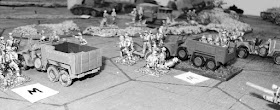The Royal Arsenal Museum (or
Tøjhusmuseet) in Copenhagen has a large collection of ship models on display, including a number of early armoured ships.
Dannebrog (Steam-powered Ironclad)
Dannebrog was originally built in 1853 as a ship-of-the-line, and was converted into an ironclad frigate between 1862 and 1864. When first converted she armed with 14 x 60-pounder rifled guns and 3 x 18-pounder rifled guns, but this was changed in 1865 to 6 x 60-pounder rifled guns and 8 x 24-pounder rifled guns. She was decommissioned in 1875, and was then used a training ship and floating barracks.
Rolf Krake (Turret ship)
Designed by Captain Coles and built by R. Napier & Sons, Glasgow, Scotland in 1863. She was originally armed with 4 x 60-pounder rifled guns (two in each turret), but later she was rearmed and carried 2 x 8" guns (two in each turret), 2 x 3" guns, and 4 x 37mm Hotchkiss revolving cannons. She took and active part in the 2nd Schleswig War and was finally decommissioned in 1907.
Falster (Gunboat)
Built by the Royal Naval Shipyard, Copenhagen between 1873 and 1874, she was originally armed with 1 x 10" gun and 2 x 4-pounder rifled guns, but later rearmed with 1 x 57mm rapid-firing gun and 6 x 37mm automatic cannons. After active service during the First World War, she was decommissioned in 1919, renamed
Holger and converted into a dredger.
Helgoland (Armoured Ship/Ironclad Monitor)
Built by the Royal Naval Shipyard, Copenhagen between 1876 and 1878, she was originally armed with 1 × 12" gun, 4 × 10.2" guns, and 5 × 4.7" guns, but the 4.7" guns were later removed and replaced by 2 x 57mm rapid-firing guns, 4 x 37mm Hotchkiss revolving cannons, 3 x 37mm rapid-firing guns, 2 x 8mm machine guns, 2 x 15" torpedo tubes (in the bows), and 2 x 14" torpedo tubes. She was decommissioned in 1907 and scrapped.
Tordenskold (Armoured Ship/Torpedo Ram)
Built by the Royal Naval Shipyard, Copenhagen between 1879 and 1880, she was originally armed with 1 × 14" gun, 4 × 4.7" guns, 4 x 37mm Hotchkiss revolving cannons, 1 x 15" torpedo tube (in the bows), and 3 x 14" torpedo tubes. At a later date 2 x 37mm rapid-firing guns, 2 additional Hotchkiss revolving cannons, and 2 x 8mm machine guns were added. She was decommissioned in 1908 and scrapped.
Iver Hvitfeld (Armoured Ship/Coastal Defence Battleship)
Built by the Royal Naval Shipyard, Copenhagen between 1886 and 1887, she was armed with 2 × 10.2" guns, 4 × 4.7" guns, 2 x 57mm rapid-firing guns, 6 x 37mm Hotchkiss revolving cannons, 2 x 37mm rapid-firing guns, 2 x 8mm machine guns, 1 x 15" torpedo tube (in the bows), and 3 x 14" torpedo tubes. She was decommissioned in 1919.
Valkyrien (Cruiser)
Built by the Royal Naval Shipyard, Copenhagen between 1886 and 1888, she was armed with 2 × 8.2" guns, 6 × 5.9" guns, 4 x 57mm rapid-firing guns, 6 x 37mm rapid-firing guns, 2 x 8mm machine guns, and 5 x 15" torpedo tube (two in the bows, one in the stern, and two amidships). She was rearmed in 1915, after which she carried 2 × 8.2" guns, 6 × 75mm guns, 2 x 57mm rapid-firing guns, 2 x 37mm rapid-firing guns, and 3 x 15" torpedo tube (two in the bows and one in the stern). She spent the latter years of her service as a training ship, and was decommissioned in 1923.

















































